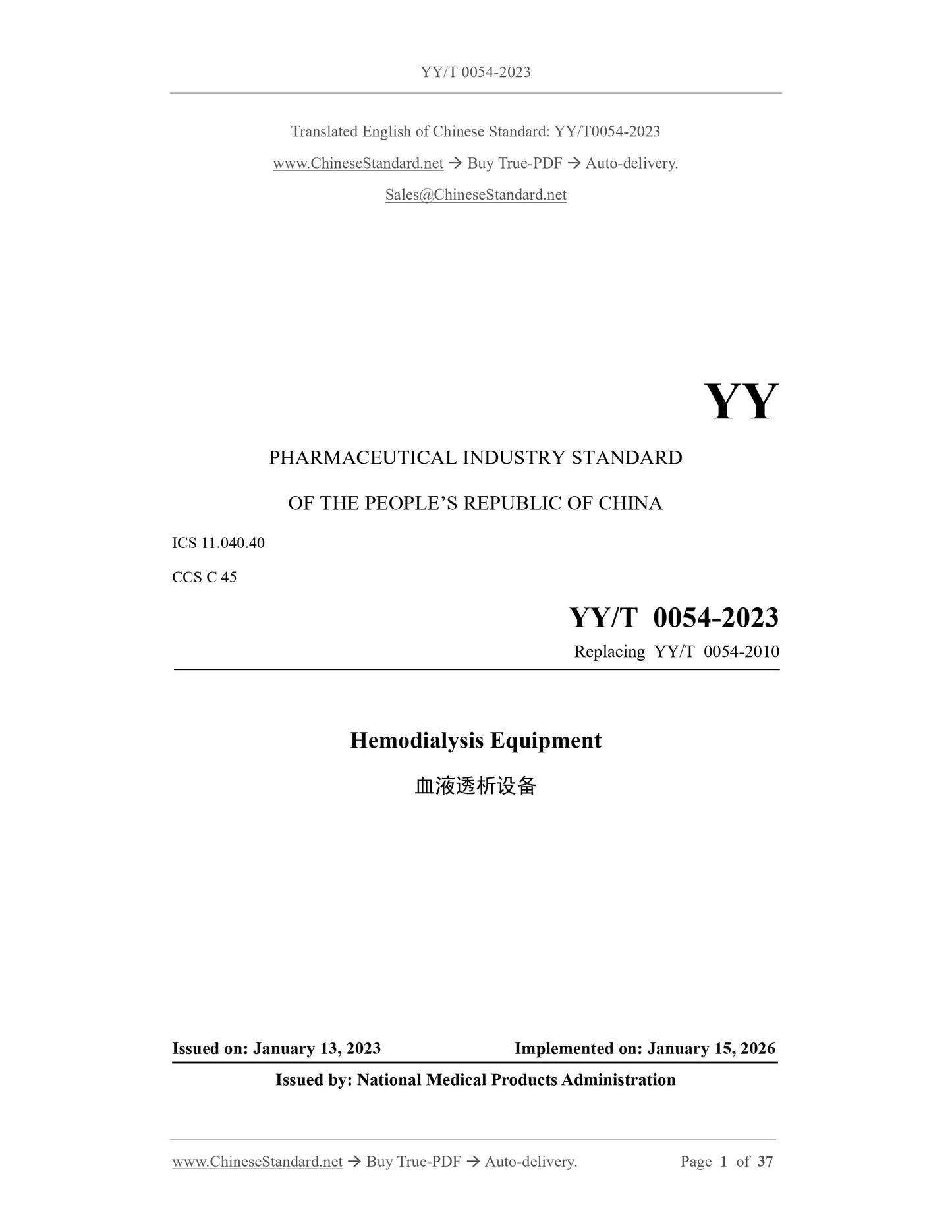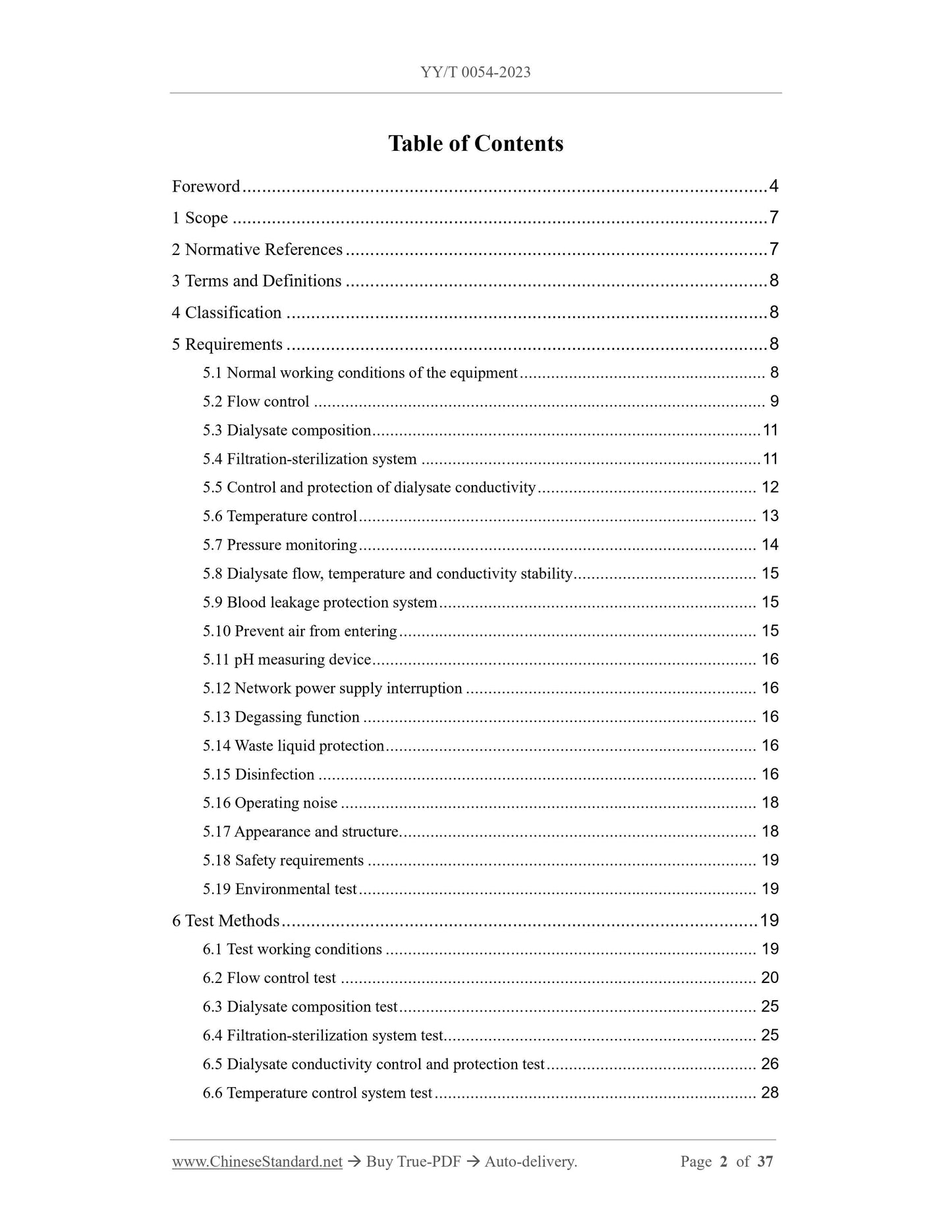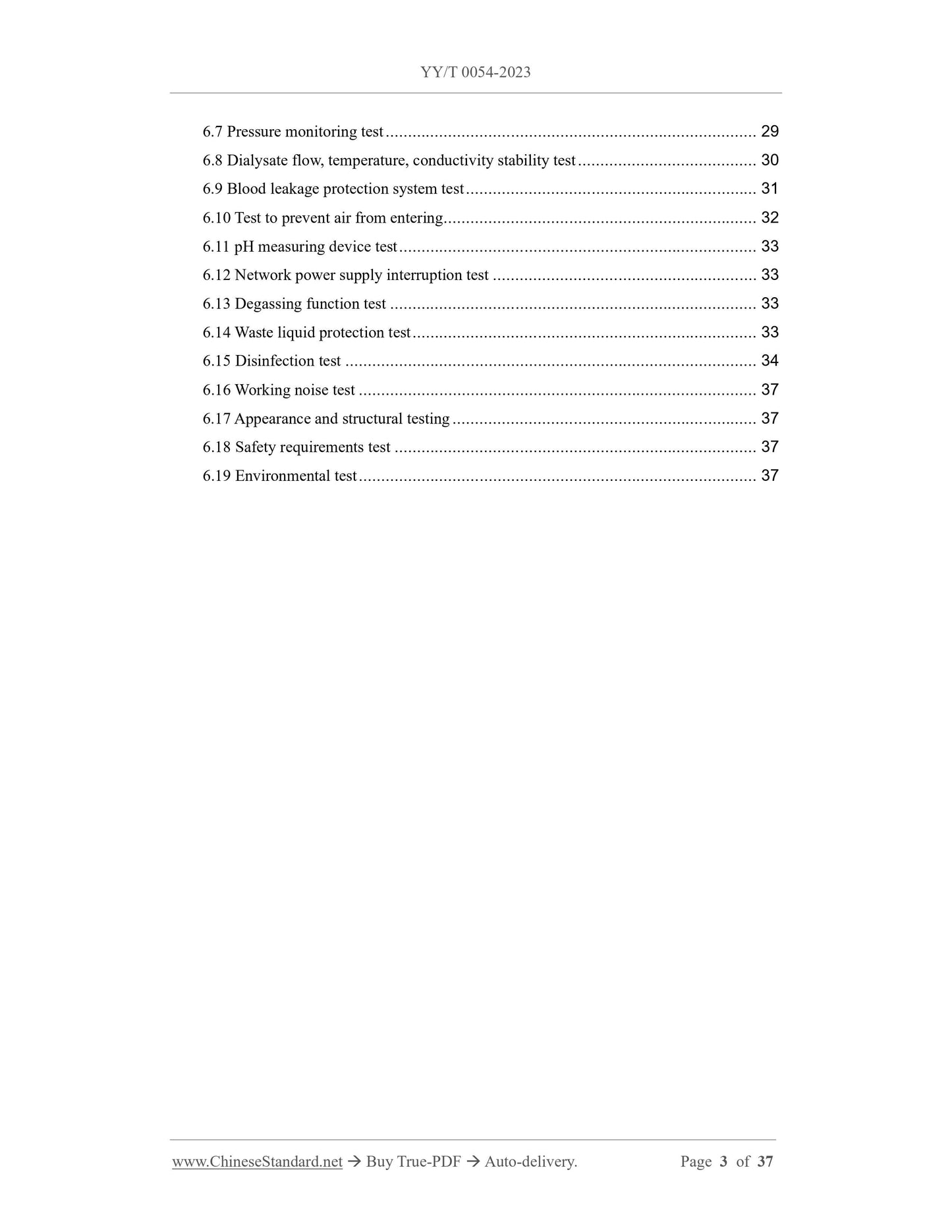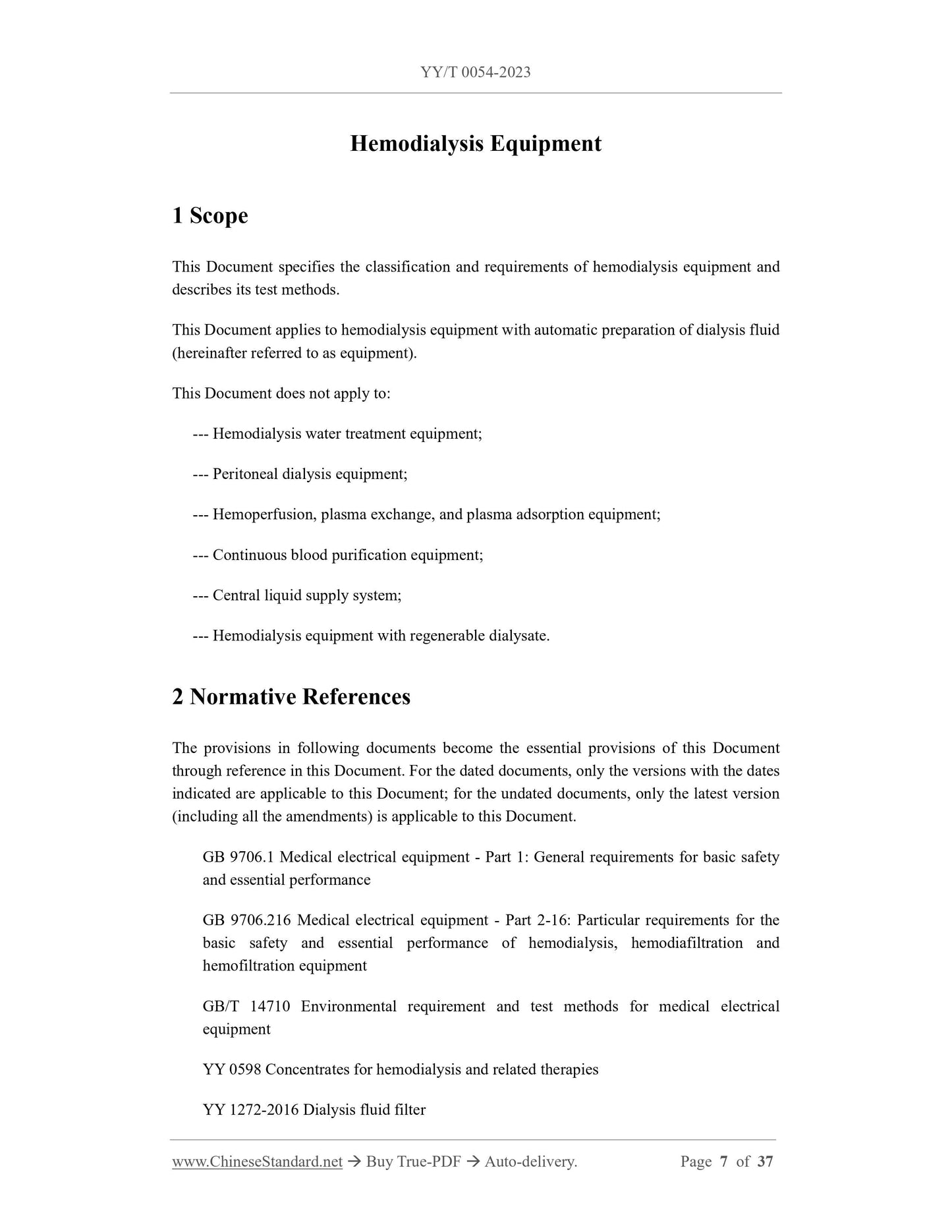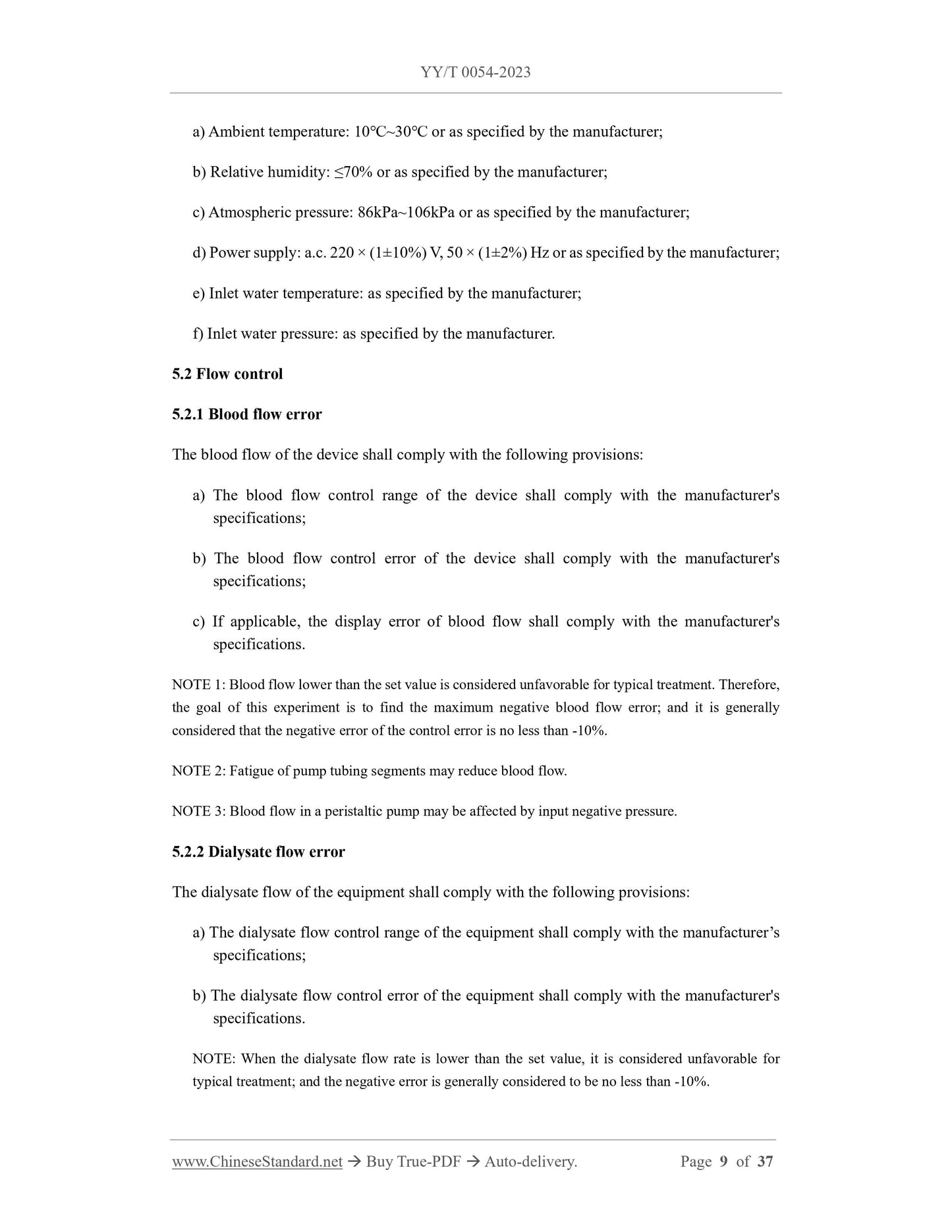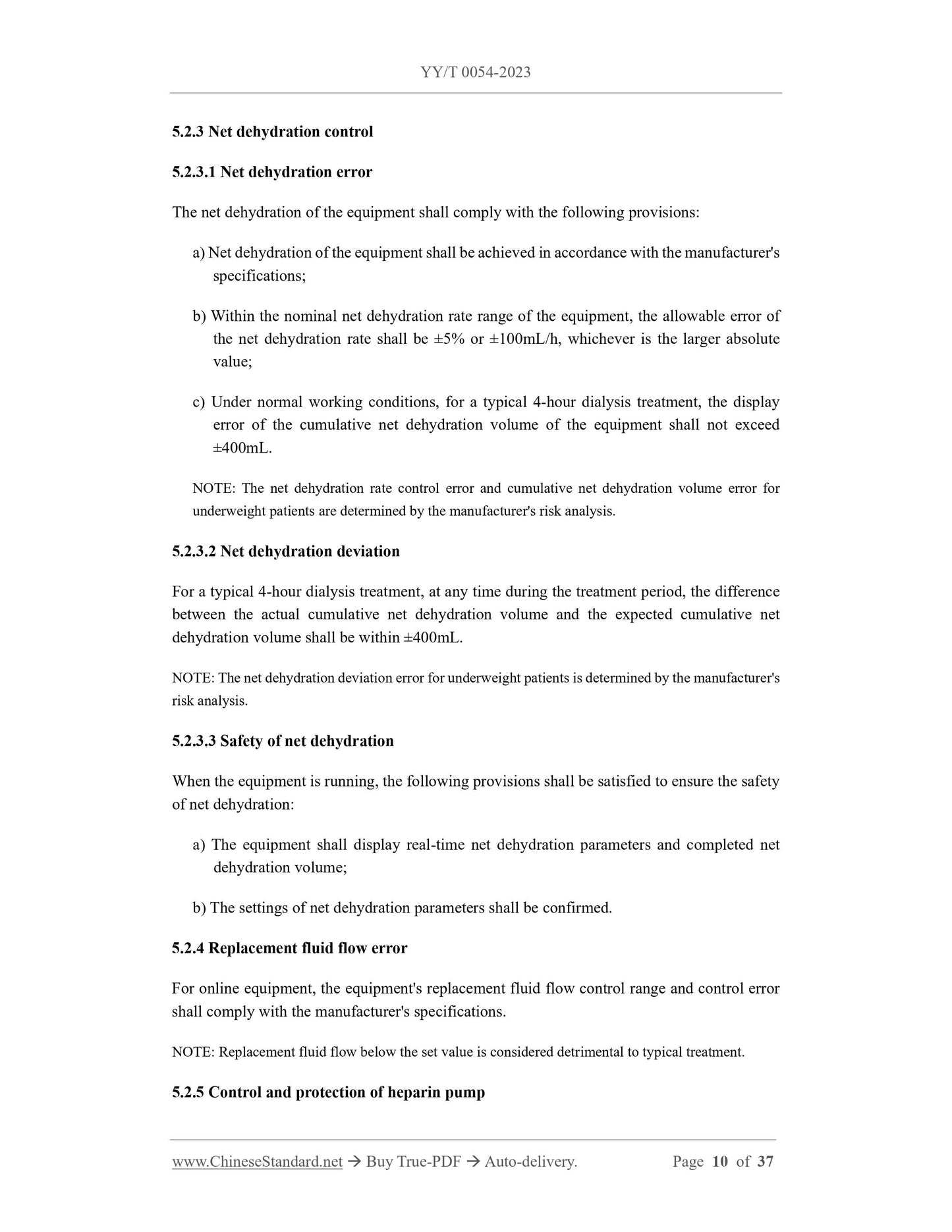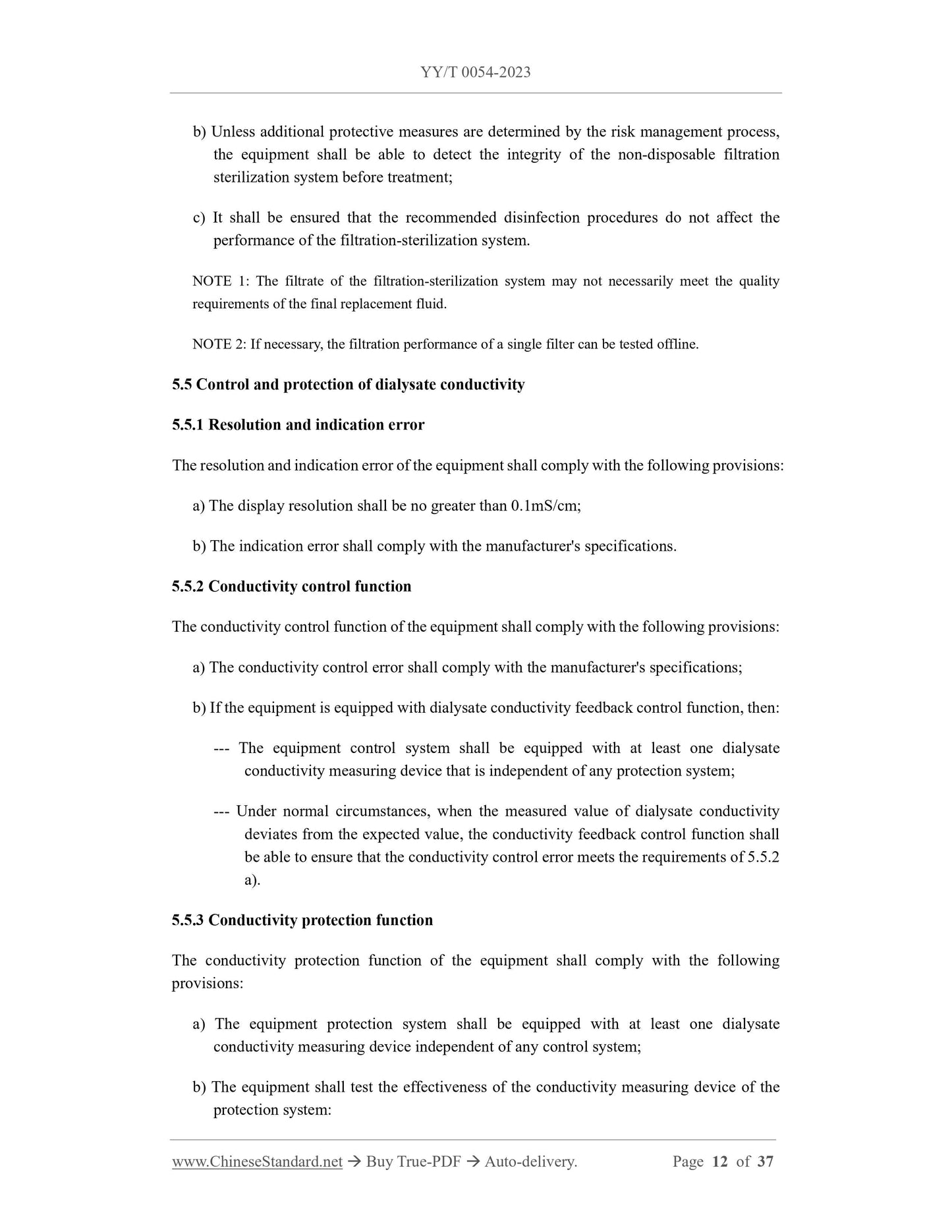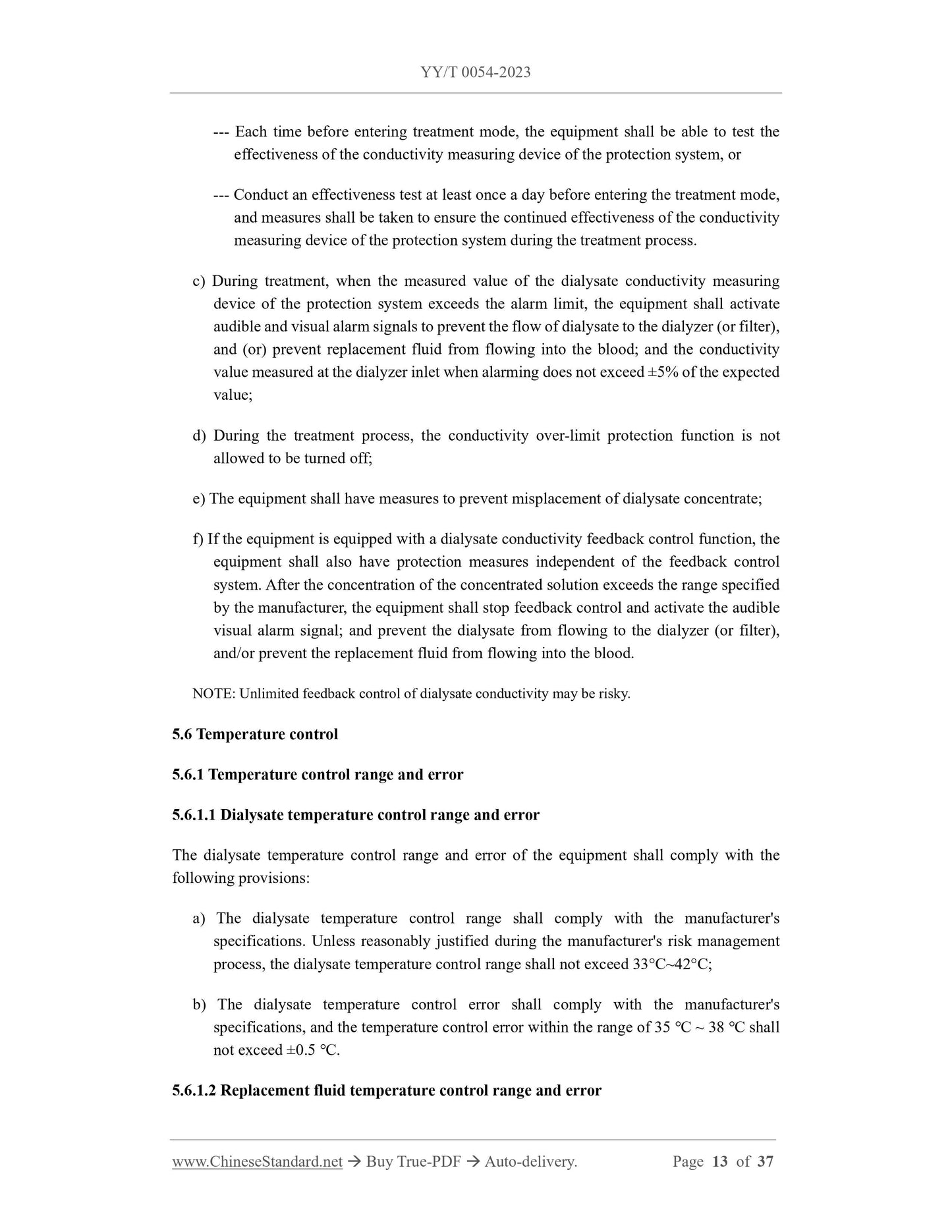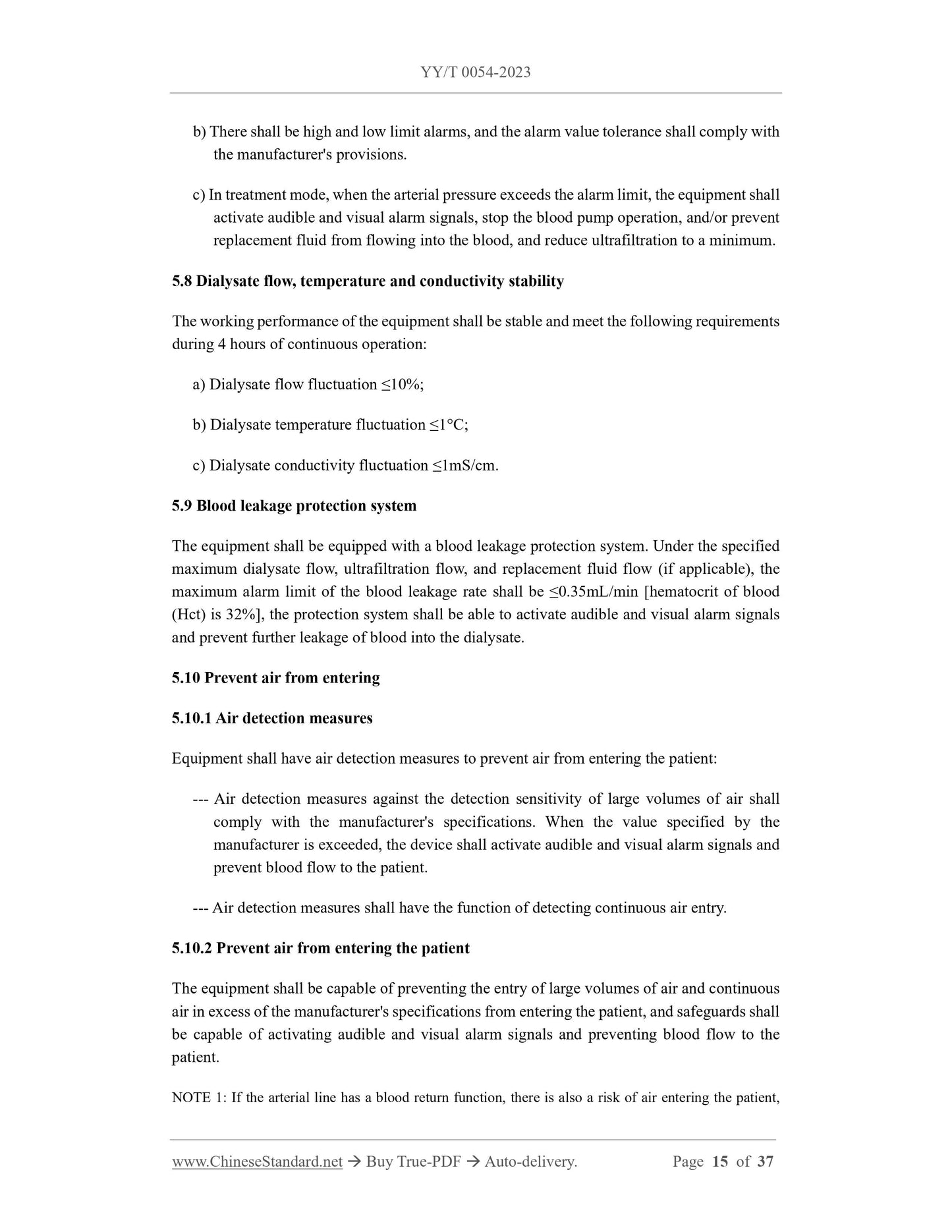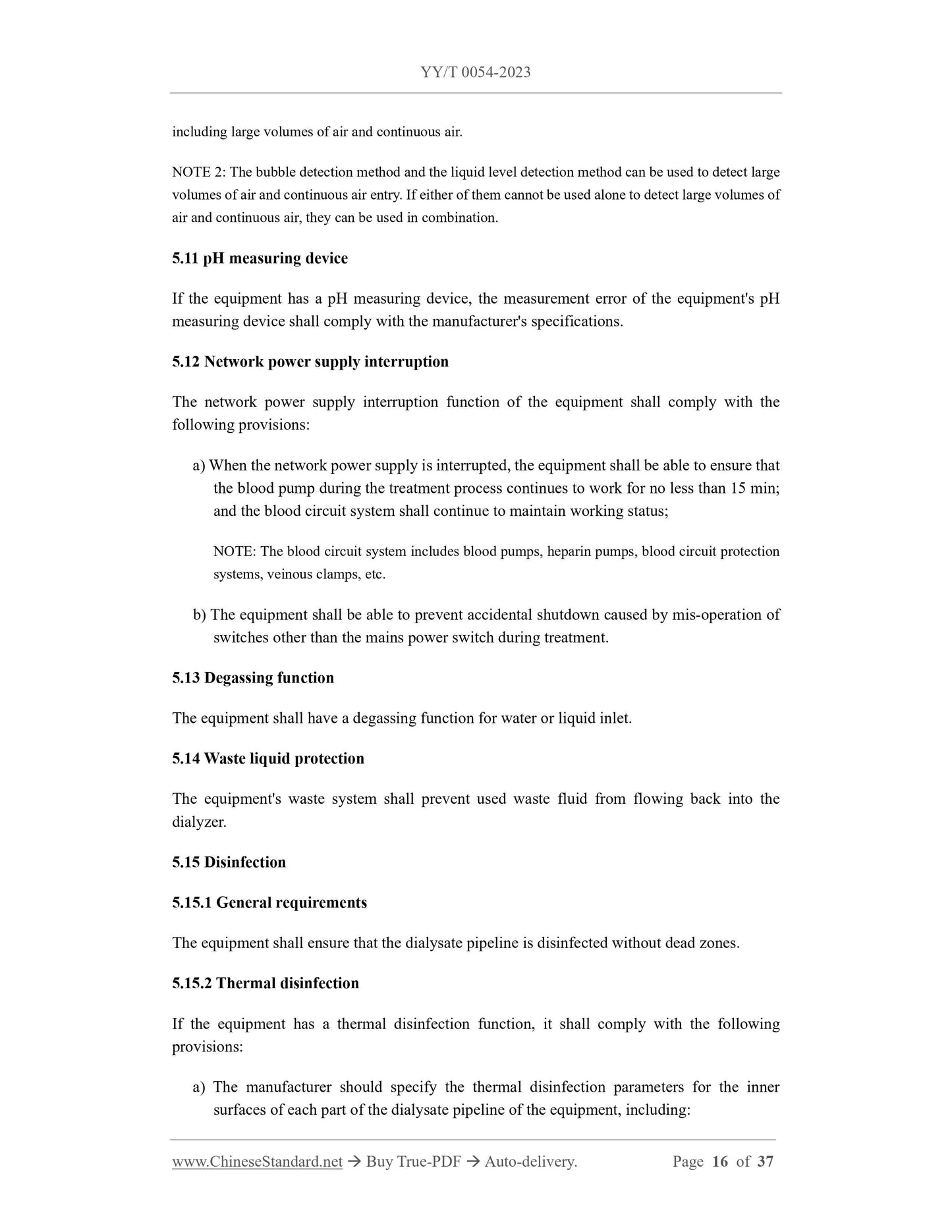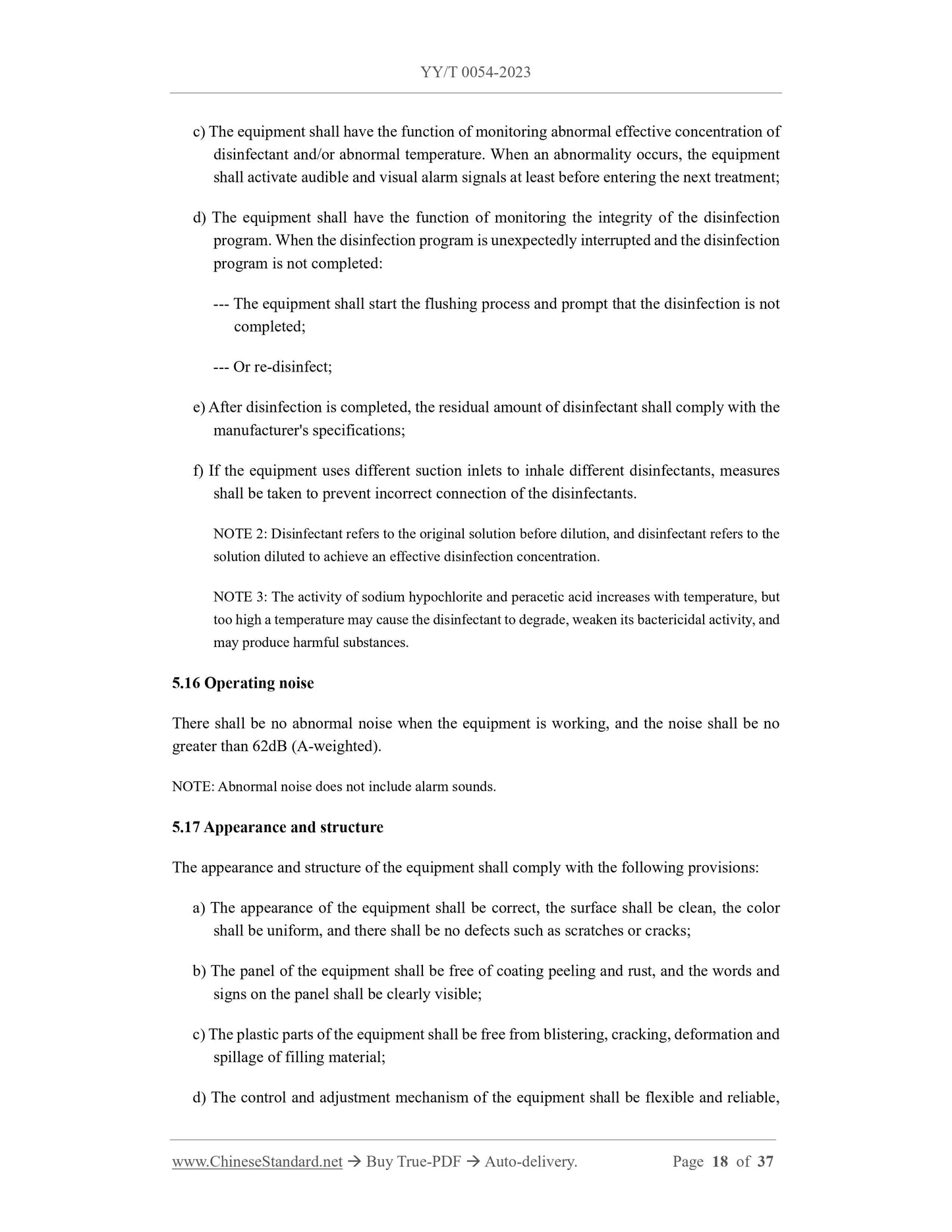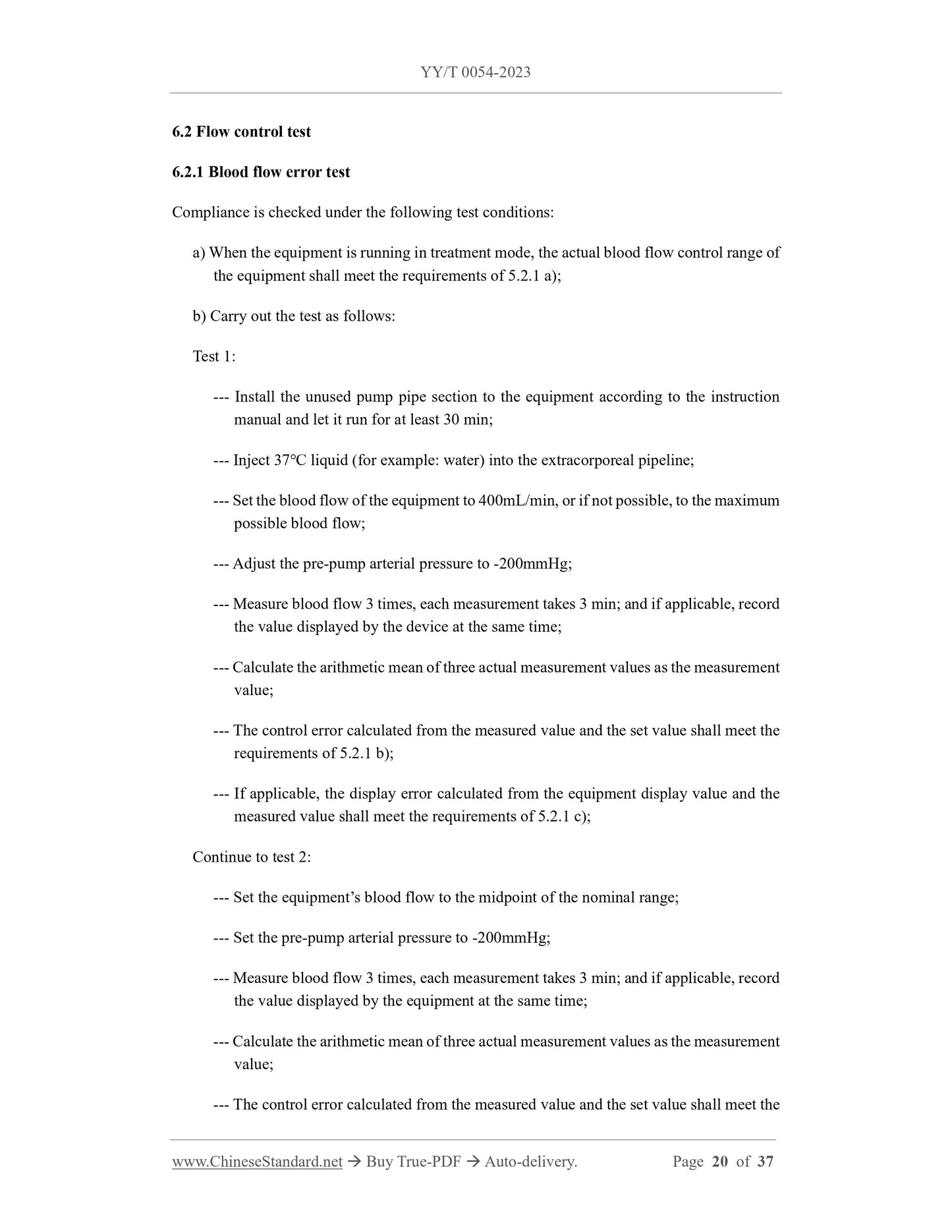1
/
of
12
PayPal, credit cards. Download editable-PDF and invoice in 1 second!
YY 0054-2023 English PDF
YY 0054-2023 English PDF
Regular price
$365.00 USD
Regular price
Sale price
$365.00 USD
Unit price
/
per
Shipping calculated at checkout.
Couldn't load pickup availability
Delivery: 3 seconds. Download true-PDF + Invoice.
Get QUOTATION in 1-minute: Click YY 0054-2023
Historical versions: YY 0054-2023
Preview True-PDF (Reload/Scroll if blank)
YY 0054-2023: Specification for management of ecological and environmental archives -- -- Ecological and environmental protection of construction project
YY/T 0054-2023
YY
PHARMACEUTICAL INDUSTRY STANDARD
OF THE PEOPLE’S REPUBLIC OF CHINA
ICS 11.040.40
CCS C 45
Replacing YY/T 0054-2010
Hemodialysis Equipment
血液透析设备
ISSUED ON: JANUARY 13, 2023
IMPLEMENTED ON: JANUARY 15, 2026
Issued by: National Medical Products Administration
Table of Contents
Foreword ... 4
1 Scope ... 7
2 Normative References ... 7
3 Terms and Definitions ... 8
4 Classification ... 8
5 Requirements ... 8
5.1 Normal working conditions of the equipment ... 8
5.2 Flow control ... 9
5.3 Dialysate composition ... 11
5.4 Filtration-sterilization system ... 11
5.5 Control and protection of dialysate conductivity ... 12
5.6 Temperature control ... 13
5.7 Pressure monitoring ... 14
5.8 Dialysate flow, temperature and conductivity stability ... 15
5.9 Blood leakage protection system ... 15
5.10 Prevent air from entering ... 15
5.11 pH measuring device ... 16
5.12 Network power supply interruption ... 16
5.13 Degassing function ... 16
5.14 Waste liquid protection ... 16
5.15 Disinfection ... 16
5.16 Operating noise ... 18
5.17 Appearance and structure ... 18
5.18 Safety requirements ... 19
5.19 Environmental test ... 19
6 Test Methods ... 19
6.1 Test working conditions ... 19
6.2 Flow control test ... 20
6.3 Dialysate composition test ... 25
6.4 Filtration-sterilization system test ... 25
6.5 Dialysate conductivity control and protection test ... 26
6.6 Temperature control system test ... 28
6.7 Pressure monitoring test ... 29
6.8 Dialysate flow, temperature, conductivity stability test ... 30
6.9 Blood leakage protection system test ... 31
6.10 Test to prevent air from entering ... 32
6.11 pH measuring device test ... 33
6.12 Network power supply interruption test ... 33
6.13 Degassing function test ... 33
6.14 Waste liquid protection test ... 33
6.15 Disinfection test ... 34
6.16 Working noise test ... 37
6.17 Appearance and structural testing ... 37
6.18 Safety requirements test ... 37
6.19 Environmental test ... 37
Hemodialysis Equipment
1 Scope
This Document specifies the classification and requirements of hemodialysis equipment and
describes its test methods.
This Document applies to hemodialysis equipment with automatic preparation of dialysis fluid
(hereinafter referred to as equipment).
This Document does not apply to:
--- Hemodialysis water treatment equipment;
--- Peritoneal dialysis equipment;
--- Hemoperfusion, plasma exchange, and plasma adsorption equipment;
--- Continuous blood purification equipment;
--- Central liquid supply system;
--- Hemodialysis equipment with regenerable dialysate.
2 Normative References
The provisions in following documents become the essential provisions of this Document
through reference in this Document. For the dated documents, only the versions with the dates
indicated are applicable to this Document; for the undated documents, only the latest version
(including all the amendments) is applicable to this Document.
GB 9706.1 Medical electrical equipment - Part 1: General requirements for basic safety
and essential performance
GB 9706.216 Medical electrical equipment - Part 2-16: Particular requirements for the
basic safety and essential performance of hemodialysis, hemodiafiltration and
hemofiltration equipment
GB/T 14710 Environmental requirement and test methods for medical electrical
equipment
YY 0598 Concentrates for hemodialysis and related therapies
YY 1272-2016 Dialysis fluid filter
a) Ambient temperature: 10℃~30℃ or as specified by the manufacturer;
b) Relative humidity: ≤70% or as specified by the manufacturer;
c) Atmospheric pressure: 86kPa~106kPa or as specified by the manufacturer;
d) Power supply: a.c. 220 × (1±10%) V, 50 × (1±2%) Hz or as specified by the manufacturer;
e) Inlet water temperature: as specified by the manufacturer;
f) Inlet water pressure: as specified by the manufacturer.
5.2 Flow control
5.2.1 Blood flow error
The blood flow of the device shall comply with the following provisions:
a) The blood flow control range of the device shall comply with the manufacturer's
specifications;
b) The blood flow control error of the device shall comply with the manufacturer's
specifications;
c) If applicable, the display error of blood flow shall comply with the manufacturer's
specifications.
NOTE 1: Blood flow lower than the set value is considered unfavorable for typical treatment. Therefore,
the goal of this experiment is to find the maximum negative blood flow error; and it is generally
considered that the negative error of the control error is no less than -10%.
NOTE 2: Fatigue of pump tubing segments may reduce blood flow.
NOTE 3: Blood flow in a peristaltic pump may be affected by input negative pressure.
5.2.2 Dialysate flow error
The dialysate flow of the equipment shall comply with the following provisions:
a) The dialysate flow control range of the equipment shall comply with the manufacturer’s
specifications;
b) The dialysate flow control error of the equipment shall comply with the manufacturer's
specifications.
NOTE: When the dialysate flow rate is lower than the set value, it is considered unfavorable for
typical treatment; and the negative error is generally considered to be no less than -10%.
5.2.3 Net dehydration control
5.2.3.1 Net dehydration error
The net dehydration of the equipment shall comply with the following provisions:
a) Net dehydration of the equipment shall be achieved in accordance with the manufacturer's
specifications;
b) Within the nominal net dehydration rate range of the equipment, the allowable error of
the net dehydration rate shall be ±5% or ±100mL/h, whichever is the larger absolute
value;
c) Under normal working conditions, for a typical 4-hour dialysis treatment, the display
error of the cumulative net dehydration volume of the equipment shall not exceed
±400mL.
NOTE: The net dehydration rate control error and cumulative net dehydration volume error for
underweight patients are determined by the manufacturer's risk analysis.
5.2.3.2 Net dehydration deviation
For a typical 4-hour dialysis treatment, at any time during the treatment period, the difference
between the actual cumulative net dehydration volume and the expected cumulative net
dehydration volume shall be within ±400mL.
NOTE: The net dehydration deviation error for underweight patients is determined by the manufacturer's
risk analysis.
5.2.3.3 Safety of net dehydration
When the equipment is running, the following provisions shall be satisfied to ensure the safety
of net dehydration:
a) The equipment shall display real-time net dehydration parameters and completed net
dehydration volume;
b) The settings of net dehydration parameters shall be confirmed.
5.2.4 Replacement fluid flow error
For online equipment, the equipment's replacement fluid flow control range and control error
shall comply with the manufacturer's specifications.
NOTE: Replacement fluid flow below the set value is considered detrimental to typical treatment.
5.2.5 Control and protection of heparin pump
b) Unless additional protective measures are determined by the risk management process,
the equipment shall be able to detect the integrity of the non-disposable filtration
sterilization system before treatment;
c) It shall be ensured that the recommended disinfection procedures do not affect the
...
Get QUOTATION in 1-minute: Click YY 0054-2023
Historical versions: YY 0054-2023
Preview True-PDF (Reload/Scroll if blank)
YY 0054-2023: Specification for management of ecological and environmental archives -- -- Ecological and environmental protection of construction project
YY/T 0054-2023
YY
PHARMACEUTICAL INDUSTRY STANDARD
OF THE PEOPLE’S REPUBLIC OF CHINA
ICS 11.040.40
CCS C 45
Replacing YY/T 0054-2010
Hemodialysis Equipment
血液透析设备
ISSUED ON: JANUARY 13, 2023
IMPLEMENTED ON: JANUARY 15, 2026
Issued by: National Medical Products Administration
Table of Contents
Foreword ... 4
1 Scope ... 7
2 Normative References ... 7
3 Terms and Definitions ... 8
4 Classification ... 8
5 Requirements ... 8
5.1 Normal working conditions of the equipment ... 8
5.2 Flow control ... 9
5.3 Dialysate composition ... 11
5.4 Filtration-sterilization system ... 11
5.5 Control and protection of dialysate conductivity ... 12
5.6 Temperature control ... 13
5.7 Pressure monitoring ... 14
5.8 Dialysate flow, temperature and conductivity stability ... 15
5.9 Blood leakage protection system ... 15
5.10 Prevent air from entering ... 15
5.11 pH measuring device ... 16
5.12 Network power supply interruption ... 16
5.13 Degassing function ... 16
5.14 Waste liquid protection ... 16
5.15 Disinfection ... 16
5.16 Operating noise ... 18
5.17 Appearance and structure ... 18
5.18 Safety requirements ... 19
5.19 Environmental test ... 19
6 Test Methods ... 19
6.1 Test working conditions ... 19
6.2 Flow control test ... 20
6.3 Dialysate composition test ... 25
6.4 Filtration-sterilization system test ... 25
6.5 Dialysate conductivity control and protection test ... 26
6.6 Temperature control system test ... 28
6.7 Pressure monitoring test ... 29
6.8 Dialysate flow, temperature, conductivity stability test ... 30
6.9 Blood leakage protection system test ... 31
6.10 Test to prevent air from entering ... 32
6.11 pH measuring device test ... 33
6.12 Network power supply interruption test ... 33
6.13 Degassing function test ... 33
6.14 Waste liquid protection test ... 33
6.15 Disinfection test ... 34
6.16 Working noise test ... 37
6.17 Appearance and structural testing ... 37
6.18 Safety requirements test ... 37
6.19 Environmental test ... 37
Hemodialysis Equipment
1 Scope
This Document specifies the classification and requirements of hemodialysis equipment and
describes its test methods.
This Document applies to hemodialysis equipment with automatic preparation of dialysis fluid
(hereinafter referred to as equipment).
This Document does not apply to:
--- Hemodialysis water treatment equipment;
--- Peritoneal dialysis equipment;
--- Hemoperfusion, plasma exchange, and plasma adsorption equipment;
--- Continuous blood purification equipment;
--- Central liquid supply system;
--- Hemodialysis equipment with regenerable dialysate.
2 Normative References
The provisions in following documents become the essential provisions of this Document
through reference in this Document. For the dated documents, only the versions with the dates
indicated are applicable to this Document; for the undated documents, only the latest version
(including all the amendments) is applicable to this Document.
GB 9706.1 Medical electrical equipment - Part 1: General requirements for basic safety
and essential performance
GB 9706.216 Medical electrical equipment - Part 2-16: Particular requirements for the
basic safety and essential performance of hemodialysis, hemodiafiltration and
hemofiltration equipment
GB/T 14710 Environmental requirement and test methods for medical electrical
equipment
YY 0598 Concentrates for hemodialysis and related therapies
YY 1272-2016 Dialysis fluid filter
a) Ambient temperature: 10℃~30℃ or as specified by the manufacturer;
b) Relative humidity: ≤70% or as specified by the manufacturer;
c) Atmospheric pressure: 86kPa~106kPa or as specified by the manufacturer;
d) Power supply: a.c. 220 × (1±10%) V, 50 × (1±2%) Hz or as specified by the manufacturer;
e) Inlet water temperature: as specified by the manufacturer;
f) Inlet water pressure: as specified by the manufacturer.
5.2 Flow control
5.2.1 Blood flow error
The blood flow of the device shall comply with the following provisions:
a) The blood flow control range of the device shall comply with the manufacturer's
specifications;
b) The blood flow control error of the device shall comply with the manufacturer's
specifications;
c) If applicable, the display error of blood flow shall comply with the manufacturer's
specifications.
NOTE 1: Blood flow lower than the set value is considered unfavorable for typical treatment. Therefore,
the goal of this experiment is to find the maximum negative blood flow error; and it is generally
considered that the negative error of the control error is no less than -10%.
NOTE 2: Fatigue of pump tubing segments may reduce blood flow.
NOTE 3: Blood flow in a peristaltic pump may be affected by input negative pressure.
5.2.2 Dialysate flow error
The dialysate flow of the equipment shall comply with the following provisions:
a) The dialysate flow control range of the equipment shall comply with the manufacturer’s
specifications;
b) The dialysate flow control error of the equipment shall comply with the manufacturer's
specifications.
NOTE: When the dialysate flow rate is lower than the set value, it is considered unfavorable for
typical treatment; and the negative error is generally considered to be no less than -10%.
5.2.3 Net dehydration control
5.2.3.1 Net dehydration error
The net dehydration of the equipment shall comply with the following provisions:
a) Net dehydration of the equipment shall be achieved in accordance with the manufacturer's
specifications;
b) Within the nominal net dehydration rate range of the equipment, the allowable error of
the net dehydration rate shall be ±5% or ±100mL/h, whichever is the larger absolute
value;
c) Under normal working conditions, for a typical 4-hour dialysis treatment, the display
error of the cumulative net dehydration volume of the equipment shall not exceed
±400mL.
NOTE: The net dehydration rate control error and cumulative net dehydration volume error for
underweight patients are determined by the manufacturer's risk analysis.
5.2.3.2 Net dehydration deviation
For a typical 4-hour dialysis treatment, at any time during the treatment period, the difference
between the actual cumulative net dehydration volume and the expected cumulative net
dehydration volume shall be within ±400mL.
NOTE: The net dehydration deviation error for underweight patients is determined by the manufacturer's
risk analysis.
5.2.3.3 Safety of net dehydration
When the equipment is running, the following provisions shall be satisfied to ensure the safety
of net dehydration:
a) The equipment shall display real-time net dehydration parameters and completed net
dehydration volume;
b) The settings of net dehydration parameters shall be confirmed.
5.2.4 Replacement fluid flow error
For online equipment, the equipment's replacement fluid flow control range and control error
shall comply with the manufacturer's specifications.
NOTE: Replacement fluid flow below the set value is considered detrimental to typical treatment.
5.2.5 Control and protection of heparin pump
b) Unless additional protective measures are determined by the risk management process,
the equipment shall be able to detect the integrity of the non-disposable filtration
sterilization system before treatment;
c) It shall be ensured that the recommended disinfection procedures do not affect the
...
Share
